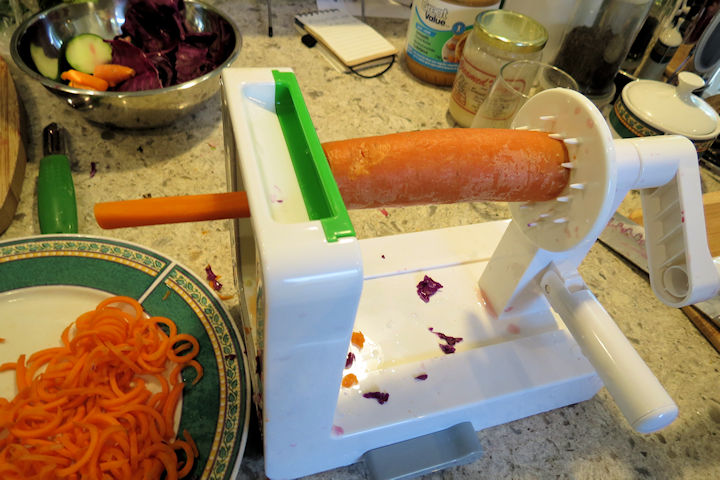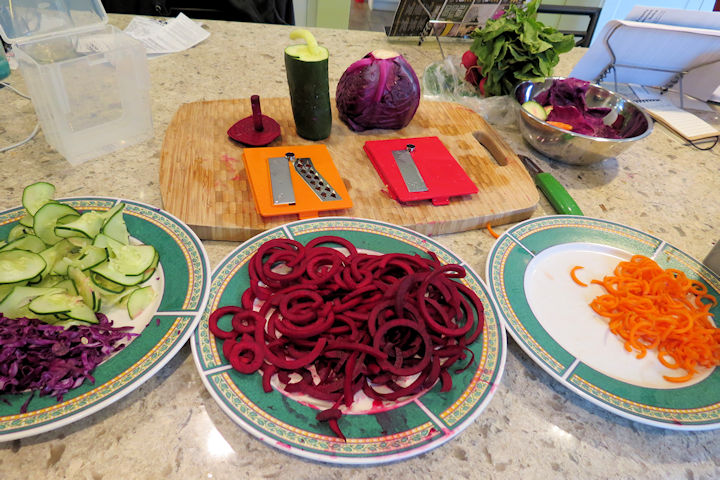![]()
 I bought myself a spiral veggie cutter recently – a spiralizer, they’re called – after hearing a friend rave on about how wonderful his was. And since I both like to cook and I’m a gadget freak, I thought I ought to get myself one, too. And as an added bonus, I eat a lot of veggies and stir fry dishes. Sounded like a perfect match. Oh, and they are called by other names, too, like spiral slicers and spiral cutters.
I bought myself a spiral veggie cutter recently – a spiralizer, they’re called – after hearing a friend rave on about how wonderful his was. And since I both like to cook and I’m a gadget freak, I thought I ought to get myself one, too. And as an added bonus, I eat a lot of veggies and stir fry dishes. Sounded like a perfect match. Oh, and they are called by other names, too, like spiral slicers and spiral cutters.
Somehow I must have missed the bandwagon because these things are all the rage, with dozens to choose from through in store and online sellers and websites gushing all over them. I suspect they get advertised on TV, which, of course, we don’t subscribe to.
Locally, I found a few models in the nearby Bed, Bath & Beyond, both the handheld and tabletop varieties, each marked with packaging claims to be the best, easiest, toughest and so on, but nothing independent to tell me which was good, better, or would best fulfill my fantasies as a soon-to-be madly spiralizing chef. I didn’t go on to search for them in other stores, because at this point I realized I needed to know more to be a properly informed consumer. That meant the internet.
Research time. One of my favourite pastimes. I quickly ruled out the models that are basically bladed funnels into which you corkscrew a veggie shaft (never mind the sexual innuendoes…). Not enough control over the results, only one type of output, too likely to make my wrists sore and, from what I could see, the most likely to create waste from the ends. Besides, I figured that exposed, sharp blade was an accident in the waiting. At my age and declining dexterity (daily ukulele playing notwithstanding), you think about things like that. Not to mention the arthritis.
Other handheld models looked safer, but still required dexterity. Turning out continuous, unbroken strands is a skill that appears to require some practice. It was said on several reviews to be much easier with a tabletop versus a handheld cutter.
 With the preferred type in mind, I spent some more time researching the various brands and models that had handles, a base and some sliding mechanism and kept fingers a safe distance from the blades. And, of course, were available in Canada.
With the preferred type in mind, I spent some more time researching the various brands and models that had handles, a base and some sliding mechanism and kept fingers a safe distance from the blades. And, of course, were available in Canada.
These models look somewhat like variations on the old tabletop apple and potato peelers, but instead of the blade shuttling up and down the length of the object of the procedure, while the veggie spins around its axis, in tabletop spiralizer the veggie moves towards a stationary blade, spinning as it is pushed forward. See the videos if you’re confused.
The size and thickness of the plastic of the holder and stand couldn’t be determined from the descriptions, but a few in their photographs looked mighty thin for that kind of regular use. And I quickly gathered that a lot of the alleged “consumer” reviews under some of them were either posted by bots or employees of a competing firm. Or of the manufacturing firm. Either way, objectivity was suspect (Amazon’s “confirmed buyer” tag for a reviewer gives one a modest faith in the reviewer’s neutrality, but not absolute).
There are all sorts of reviews online that hem and haw over the various types and styles, but I limited my searches to ones with at least three blades, and a solid base. The multiplicity of blades provides greater variation in the output. There is only so much zucchini noodle one can eat, after all. And I was also interested in the models capable of handling something with a bit more crunch than cucumber or zucchini. Like squash, potato and beet. That requires solidity of construction, and the ability to effectively cut such fibrous plants.
I was really tempted by the Paderno (also goes by other brand names, apparently) four-blade model, but couldn’t find a Canadian source (Amazon.ca didn’t list it as far as I could see). And while the three-blade model was less expensive, the shipping price quoted by the independent reseller seemed rather high in comparison to the small size and weight. However, both models garnered good reviews on some product-independent sites. The three-blade model remained top of my list until I delved into the food blogs.
 I finally decided on the Oxo Good Grips model, which was highly praised on several food/cooking blogs and sat in the middle of the price range (the top end products were double or more the price). I considered those reviews had greater veracity than the reviews on other sites. (Aside: some folks whined about the paucity of instructions that came with some models… it’s a slicer fergawdsake. It’s not the space shuttle…)
I finally decided on the Oxo Good Grips model, which was highly praised on several food/cooking blogs and sat in the middle of the price range (the top end products were double or more the price). I considered those reviews had greater veracity than the reviews on other sites. (Aside: some folks whined about the paucity of instructions that came with some models… it’s a slicer fergawdsake. It’s not the space shuttle…)
Only one of Amazon’s partner distributors offered it, but at something like triple the price I eventually paid. Bed, Bath & Beyond, however, sold the Oxo, but not locally, so I ordered it online. I should note that it is something like 50% more expensive than the Paderno, but I justified that by the comments saying it had sharper blades than its competition (which means greater longevity) and was very sturdily built.
And it showed up, two days later. I was like a kid with a new ukulele, anxious to try some shredding, slicing and spiralizing on whatever I had at hand. (Okay, you don’t slice and dice with a ukulele…). But the fridge was barren of the oft-immortalized zucchini, staple of the spiralizer crowd. I didn’t think celery, mushroom or shallot would do (although it also handles firm fruit, I didn’t dare cut up any of Susan’s apples for an experiment…). And since when did all our carrots morph into bite-sized “baby” carrots?
So I made a grocery list for the morrow (Note: I checked the local farmers’ market first, before hitting the supermarkets, and as I suspected, zucchini isn’t mature yet in Ontario…). I whittled away a few minutes washing the new device and carefully examining every component. I believe it to be as sturdily and well made as its aficionados said.
Just as an aside, my. Atlas pasta extruder is also made entirely of sturdy plastic and it works beautifully, producing lovely strings, noodles and tubes of homemade pasta without any sign of wear or breakage. And it washes easily. (The spiralizer has stainless steel blades and are a little tricky to clean, like any grater.)
Then, bereft of appropriate material to reduce into cellulose noodles, I started looking up recipes online. Not that I really need much – after all, it’s just another way of slicing veggies and not even particularly new. (think Julienne slice…) I’ve made this sort of slice with grates and knives, just not so neatly automated. However, a few hints about technique are always useful (pat down the noodles after slicing to improve cohesiveness during cooking…). But mostly it was to look for recipes that used the format to create better presentation, as well as some fresh ideas for combinations.
I discovered that I must be in the fringe of kitchen utensil users. To me a kitchen instrument is a tool, like a saw or a hammer or pliers (no, hammers and pliers aren’t for use on meals… well, okay, they have been, but not to any constructive culinary effect).
Apparently other folk see the device as a soap box; a platform for proselytizing their particular diet fads and food fantasies. In particular, the “paleo,” raw foods, wheat-free and gluten-free fads, all of which are nutritional hogwash. Yes, zucchini has fewer calories than real pasta, but calories are not the sole measure of healthiness nor taste. But the evangelical tenor of the posts in some blogs reaches religious fervour.
Readers of this blog know I have little stomach for fools and less for lifestyle fads, the vast majority of which are based on pseudoscience, gullibility and herd mentality. I rank these diets on the same credibility scale as the anti-vaccine stupidity, chemtrails, astrology, homeopathy, the Donald-Trump-for-president movement and trust in the ethics of Collingwood Council. All of them based on codswallop, superstition and disingenuous marketing. I refuse to be part of these forms of madness. I have my own madnesses, thank you.
And don’t get me started on the anti-gluten nuttiness. If you don’t have celiac and you’re on a gluten-free diet, you’re bandwagon gullible. I didn’t get a kitchen slicer as some sort of defence against the benefits of gluten. I got it to make pretty spirals and noodles, which, as you can see by the first two photos above, it did rather well.
Raw beet, cucumber, cabbage and carrot all spiralized nicely for last night’s salad. I was pleased with the device.The only thing I really need to pay attention to is getting the veggie centred. Off-kilter veggies cut into little curly pieces, not continuous strips. See the carrots, above.
Tonight I’m going to use it to slice yam, sweet potato and zucchini for a stir-fry veggie noodle dish (not sure yet, but I may bake the sweet potato and yam rather than fry it). Might toss in some grilled chicken or tofu, too.
Bottom line: I like it. Easy to use, effective and the little, droopy phallic core that remains from the spiralizing is good for a laugh, at least once (wine is recommended for increased risibility…). And it will help add variety to our daily meals, if not always in substance then in style.
There are also a lot of YouTube videos to explain spiralizing, with examples of veggies and dishes. Some are pretty amusing, others a bit dry and a few too preachy for my taste. Here are two; only the first deals with the Oxo:

